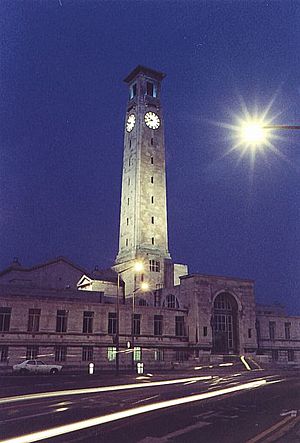Southampton Civic Centre facts for kids
Quick facts for kids Southampton Civic Centre |
|
|---|---|

Southampton Civic Centre
|
|
| Location | Southampton, England |
| Built | 1939 |
| Architect | Ernest Berry Webber |
| Architectural style(s) | Classical style |
|
Listed Building – Grade II*
|
|
| Designated | 10 October 1980 |
| Reference no. | 1092036 |
| Lua error in Module:Location_map at line 420: attempt to index field 'wikibase' (a nil value). | |
The Civic Centre is a very important building in Southampton, England. It's like the city's main office, where the local government, called Southampton City Council, works. This amazing building also holds the SeaCity Museum, the Guildhall (a big hall for events), the Southampton City Art Gallery, and the city library.
It was designed by a famous architect named Ernest Berry Webber in 1929. The building has a grand, old-fashioned look, known as the Classical style. It took ten years to build and was finished in 1939. People think it's one of the most impressive public buildings built in England between the two World Wars. Because it's so special, it was given a "Grade II* listed building" status in 1980. This means it's a very important historic building that needs to be protected.
Contents
Building the Civic Centre
How the Idea Started
For many years, starting in the 1870s, the city council needed a better place for its offices. All the different departments were spread out across Southampton, which made it hard for them to work together quickly. The old office building was just too small. After a lot of talking, the council decided to hold a competition to find the best design for a new main building.
Choosing the Design
Ernest Berry Webber won the competition with his design for the Civic Centre. He planned it in the grand Classical style. The project had a budget of almost £400,000, which was a huge amount of money back then! The first stone for the building was laid by the Duke of York (who later became King George VI) on 1 July 1930.
The South Wing: Council Offices
The first part of the Civic Centre to be finished was called the south wing. This section held the main offices for the city council. Some of the dirt dug up during its construction was used to fill in an old reservoir. This reservoir was then turned into a fun paddling pool on Southampton Common. The Duke of York and his wife, the Duchess of York, officially opened the south wing on 8 November 1932.
The West Wing: Courts and Police
Next, the west wing was built. This part of the building was home to the law courts and the police headquarters. It also features a tall tower, which is about 157 feet (48 meters) high. This tower is called "Kimber's Tower" after Sir Sidney Kimber, who was in charge of the Civic Centre project.
The west wing was opened on 3 November 1933. The tower has a clock and nine bells, made by a company called Gillett & Johnston. These bells not only chime the time but were also designed to play the hymn tune Our God, Our Help in Ages Past. This tune played at noon during the opening ceremony and then every four hours after that.
The East Wing: The Guildhall
The third part to be built was the east wing, which houses the Southampton Guildhall. Work on the Guildhall started in March 1934. The Guildhall was designed to be a grand place for city events and important gatherings. It was opened by the Earl of Derby on 13 February 1937.
The North Wing: Art and Books
Finally, the north wing was constructed. This section contains the Southampton City Art Gallery and the Southampton Central Library. The library wasn't originally part of the plan, but later changes were made to include it. Adding the library made the project cost a bit more, but Parliament approved the extra money. This last wing was opened in 1939, completing the entire Civic Centre.
Later Years of the Civic Centre
During World War II
During World War II, Southampton was heavily bombed in what was known as the Southampton Blitz. The head of the German air force, Hermann Göring, specifically targeted the Civic Centre. He even said it looked like a "piece of cake" from the sky! In November 1940, a bomb hit the Civic Centre. It went through the art gallery floors, sadly causing damage and harm to people inside.
Changes Over Time
After the war, the Civic Centre continued to be an important part of Southampton.
- In 1986, the crown court, which used to be in the west wing, moved to a new building.
- In the late 1980s, a beautiful fountain from the city's rose garden was moved to stand outside the art gallery entrance.
- The magistrates' courts moved to a larger complex in 1999.
- The police also moved out of the west wing to new facilities in 2011.
- In 2012, the SeaCity Museum moved into the newly updated west wing. It even has a modern new section added on!
Images for kids
-
The west wing, which used to be courts and now hosts the SeaCity Museum. You can also see the tall clock tower here.





